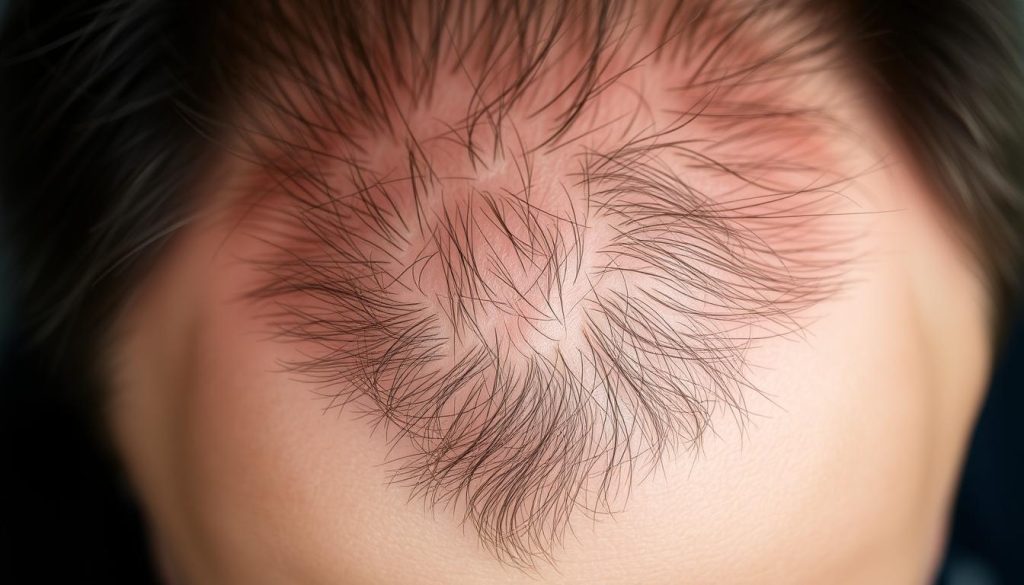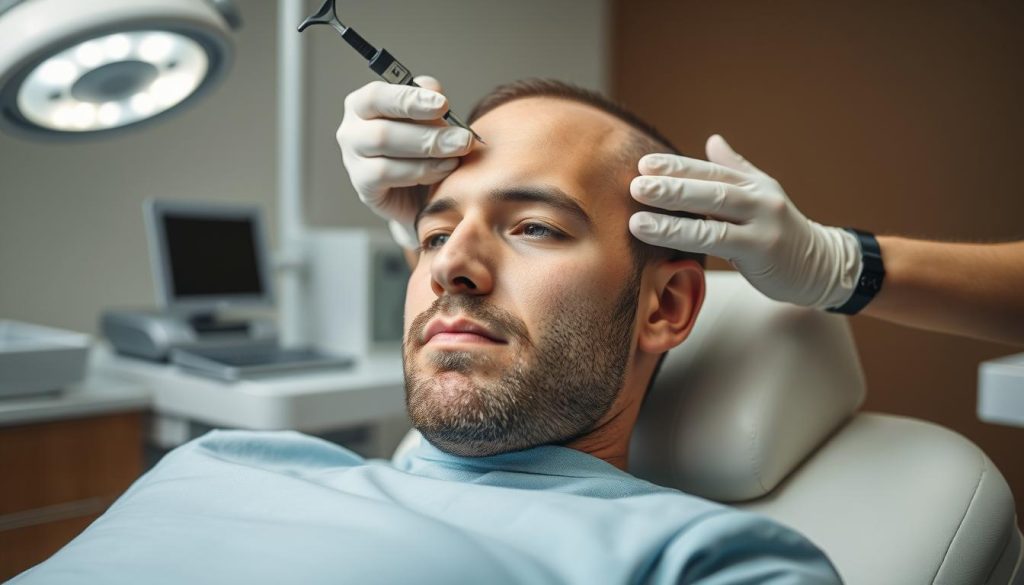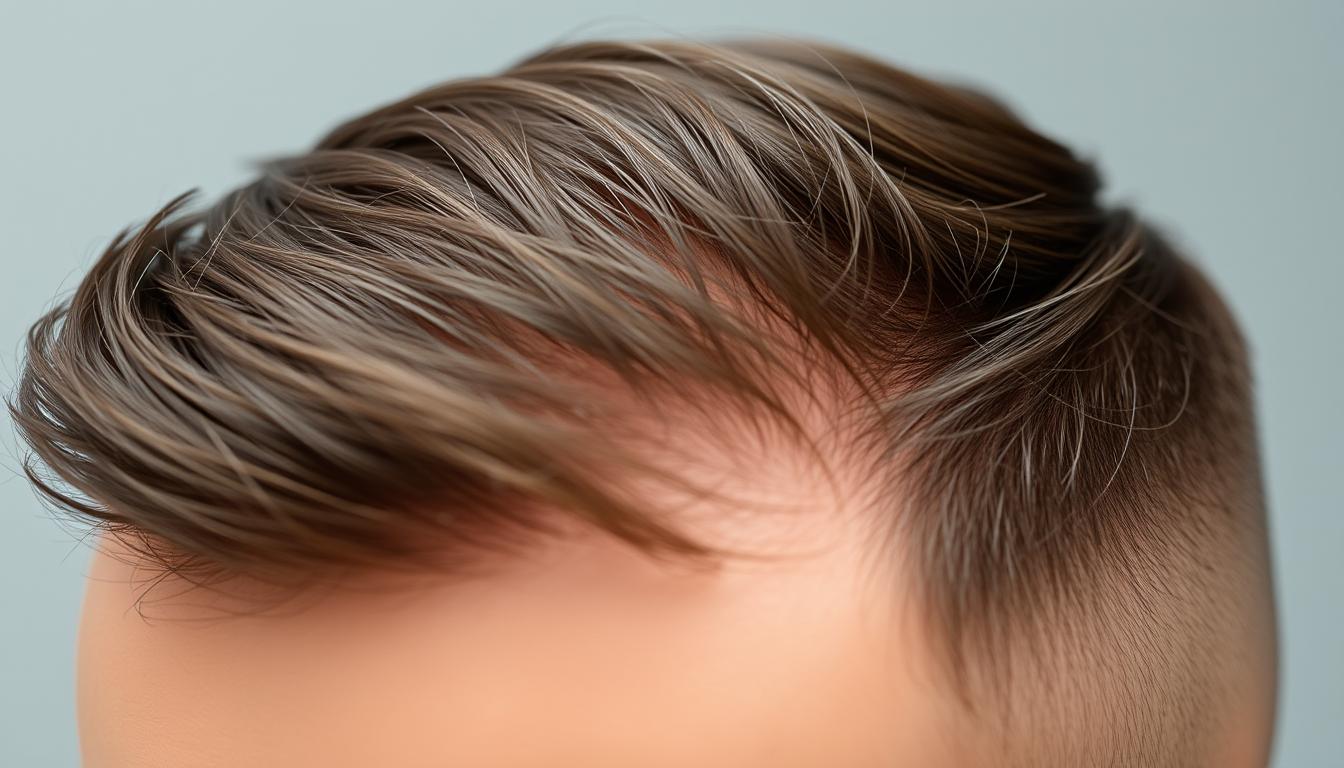For individuals experiencing hair loss, a hair transplant can be a viable solution. The procedure involves relocating hair follicles from one part of the body to another, typically to restore a natural-looking hairline.
The concept of hair transplants has evolved significantly over the years, from the early days of “hair plugs” to modern techniques that provide more natural-looking results. The key question remains: are hair transplants truly permanent?
The answer lies in understanding that hair transplants relocate follicles that are genetically resistant to balding, making the transplanted hair generally permanent. However, natural hair loss may continue in other areas, requiring ongoing management.
Key Takeaways
- Hair transplants are considered a permanent solution for hair loss.
- The procedure involves relocating genetically resistant hair follicles.
- Ongoing management may be necessary to address natural hair loss in other areas.
- Modern techniques provide more natural-looking results compared to earlier methods.
- Understanding the long-term results of hair transplants is crucial for making an informed decision.
Understanding Hair Transplantation
The concept of hair transplantation has evolved significantly over the years. Hair transplantation is a surgical procedure that involves moving hair follicles from one part of the body to another, typically to address balding or hair loss.
What Is a Hair Transplant?
A hair transplant is a procedure where hair follicles are taken from a donor site, usually the back or sides of the head, and transplanted to a recipient site, where hair is thinning or absent. This technique has been refined over decades to provide natural-looking results.
Evolution of Hair Transplant Techniques
Historically, hair transplantation involved hair plugs, which often resulted in an unnatural appearance. Modern techniques, such as follicular unit transplantation, have significantly improved outcomes. Advances in technology, including robotic-assisted transplantation, have further enhanced the precision and naturalness of hair transplants.
- Early hair plugs created an unnatural “doll’s hair” appearance.
- The shift to follicular unit transplantation in the 1990s improved results.
- Technological advancements have dramatically improved precision and outcomes.
Is Hair Transplant Permanent?
Hair transplantation has become a popular solution for individuals experiencing hair loss, but the question remains: is it a permanent fix? The answer lies in understanding the underlying principles that govern the success and longevity of hair transplants.
The Science Behind Permanence
The permanence of hair transplants is rooted in the “donor dominance theory.” This scientific principle suggests that hair follicles taken from the back and sides of the scalp retain their genetic resistance to dihydrotestosterone (DHT), a hormone that contributes to balding. As a result, when these follicles are transplanted to balding areas, they continue to grow naturally, unaffected by the hormonal influences that caused the original hair loss.

Genetic Resistance of Donor Hair
The genetic programming of hair follicles determines their susceptibility to hormonal influences. Donor hair, typically taken from areas resistant to balding, retains this resistance even after transplantation. This characteristic ensures that transplanted follicles continue to grow for a lifetime, providing a natural and permanent solution to hair loss.
| Characteristics | Donor Hair | Recipient Hair |
|---|---|---|
| Genetic Resistance to DHT | High | Variable |
| Lifelong Growth Potential | Yes | No |
| Susceptibility to Baldness | No | Yes |
As highlighted by the table, the genetic resistance of donor hair is a crucial factor in the permanence of hair transplants. While native hairs in the recipient area may continue to thin over time due to their susceptibility to balding, the transplanted hair remains resistant, ensuring a long-term solution to hair loss.
“The genetic resistance of donor hair is the cornerstone of successful hair transplantation, offering a lifelong solution to pattern baldness.”
Types of Hair Transplant Procedures
Understanding the different types of hair transplant procedures is crucial for making an informed decision about one’s hair restoration journey. Hair transplant techniques have evolved over time, offering various options to suit individual needs.
Follicular Unit Transplantation (FUT)
Follicular Unit Transplantation, commonly referred to as FUT or strip harvesting, involves removing a strip of hair-bearing skin from the donor area, typically at the back of the scalp. The strip is then dissected into individual follicular units, which are transplanted into the recipient sites. This technique allows for the transplantation of a large number of grafts in a single session.
The advantages of FUT include a higher yield of grafts and potentially lower cost compared to other methods. However, it results in a linear scar, which may be a concern for individuals who prefer very short hairstyles.
Follicular Unit Extraction (FUE)
Follicular Unit Extraction (FUE) is a technique where individual follicular units are extracted directly from the donor area using a specialized tool called a micro-punch. The extracted grafts are then transplanted into the recipient sites. FUE is known for its minimal scarring, with the donor area healing with small dots that are typically covered by existing hair.
The FUE procedure involves several steps, including preparation of the donor area, extraction of follicular units, creation of recipient sites, and placement of grafts. One of the significant advantages of FUE is its ability to allow patients to wear very short hairstyles post-procedure due to the minimal scarring.
| Technique | Scarring | Recovery Time | Cost |
|---|---|---|---|
| FUT | Linear scar | Generally longer | Potentially lower |
| FUE | Minimal (small dots) | Quicker | Potentially higher |
Both FUT and FUE have their advantages and are suited to different patient needs. Consulting with a qualified hair transplant surgeon is essential to determine the most appropriate technique for individual cases.
The Hair Transplant Timeline
Understanding the timeline of a hair transplant is crucial for managing expectations. The process involves several distinct phases, each with its own characteristics and milestones.
Initial Healing Phase (1-4 Weeks)
The initial healing phase typically lasts between 1 to 4 weeks. During this time, the body begins to heal from the transplant procedure. Patients may experience some redness, swelling, and scabbing, but these symptoms usually subside within a few weeks.
Shedding Phase (1-3 Months)
Following the initial healing, patients often enter a shedding phase that can last from 1 to 3 months. It’s common for the transplanted hair to fall out during this period. Although it may seem alarming, this shedding is a normal part of the process.
Growth Phase (4-12 Months)
The growth phase, which starts around 4 months post-transplant, is when patients begin to notice new hair growth. By 6-12 months, rapid growth continues, with approximately 60-80% of new hair regrown by the end of the first year. The characteristics of the new hair, including texture, thickness, and color, mature over time. Surgeons typically monitor progress during follow-up appointments.
| Timeframe | Phase | Characteristics |
|---|---|---|
| 1-4 Weeks | Initial Healing | Redness, swelling, scabbing |
| 1-3 Months | Shedding | Transplanted hair falls out |
| 4-12 Months | Growth | New hair growth, maturation |
Factors Affecting Long-Term Results
The success and longevity of hair transplant results are influenced by multiple factors. Understanding these elements is crucial for patients to achieve the best possible outcome from their hair transplantation procedure.
Surgeon’s Expertise and Technique
The skill and experience of the surgeon performing the hair transplant play a significant role in determining the long-term results. A surgeon with expertise in the latest techniques can significantly improve the survival rate of grafts and the overall aesthetic outcome. Choosing a qualified surgeon is paramount for achieving natural-looking and lasting results.
Patient’s Age and Hair Loss Pattern
A patient’s age and the pattern of their hair loss are critical factors that influence the long-term success of hair transplants. Younger patients may require additional procedures as they continue to experience hair loss, while the pattern of hair loss can affect the distribution and density of transplanted hair. Understanding these factors helps in setting realistic expectations.
Post-Procedure Care
Proper care after the procedure is vital for the survival of transplanted hair and achieving optimal results. Following the surgeon’s instructions for post-procedure care can significantly impact the graft survival rate and the overall density achieved. Adherence to these guidelines is crucial for minimizing complications and ensuring the best possible outcome.
| Care Aspect | Importance | Guidelines |
|---|---|---|
| Sleeping Positions | High | Avoid sleeping on the transplanted area |
| Activity Restrictions | High | Avoid strenuous activities for a few weeks |
| Sun Protection | Medium | Use sunscreen to protect the scalp |
As Dr. John Smith, a renowned hair restoration surgeon, once said,
“The key to successful hair transplantation lies not just in the surgery itself, but in the meticulous care that follows.”
Maintaining Your Hair Transplant Results
Maintaining the results of a hair transplant requires a combination of medical treatments and supportive therapies. Proper post-procedure care is essential to ensure the longevity of the transplanted hair and the overall health of the scalp.
Medical Treatments
Medical treatments such as Finasteride and Minoxidil play a crucial role in maintaining hair transplant results. Finasteride helps to slow down hair loss by inhibiting the production of dihydrotestosterone (DHT), a hormone that contributes to hair loss. Minoxidil, on the other hand, stimulates hair growth and increases the thickness of the hair. Using these treatments in conjunction with a hair transplant can enhance the overall outcome and promote healthy hair growth.
PRP Therapy and Other Supportive Treatments
 Platelet-Rich Plasma (PRP) therapy is a supportive treatment that involves injecting platelet-rich plasma (PRP) into the scalp. PRP is derived from the patient’s own blood and contains growth factors that stimulate hair growth and improve the health of the scalp. PRP therapy can be used in conjunction with hair transplants to enhance graft survival and promote faster healing. Other supportive treatments, such as low-level laser therapy (LLLT) and specialized hair supplements, can also contribute to the overall success of the hair transplant procedure.
Platelet-Rich Plasma (PRP) therapy is a supportive treatment that involves injecting platelet-rich plasma (PRP) into the scalp. PRP is derived from the patient’s own blood and contains growth factors that stimulate hair growth and improve the health of the scalp. PRP therapy can be used in conjunction with hair transplants to enhance graft survival and promote faster healing. Other supportive treatments, such as low-level laser therapy (LLLT) and specialized hair supplements, can also contribute to the overall success of the hair transplant procedure.
Potential Complications and Concerns
Understanding the potential complications and concerns of hair transplantation is vital for individuals considering this treatment for hair loss. While generally safe, the procedure can have side effects and long-term considerations that patients should be aware of.
Short-Term Side Effects
Common short-term side effects include swelling, redness, and itching at the transplant site. These effects are typically mild and resolve on their own within a few weeks. Patients are advised to follow post-operative instructions carefully to minimize these effects.
Long-Term Considerations
Long-term considerations include the potential for continued hair loss around the transplanted area, which can affect the overall appearance of the transplanted hair over time. The transplanted hair itself is generally resistant to balding, but the native hair surrounding it may continue to thin.
Addressing Continued Hair Loss
To address continued loss and maintain the desired outcome, patients may need to consider additional treatments, such as medical therapy or further transplantation. A doctor can help determine the best course of action based on the individual’s pattern of hair loss.
Cost of Hair Transplant Procedures

Understanding the financial investment required for hair transplant procedures is crucial for individuals considering this option. The cost can vary significantly based on several factors.
Factors Influencing Price
The cost of hair transplantation is influenced by factors such as the surgeon’s expertise, the technique used, and the location of the clinic. Additionally, the extent of the procedure, including the number of grafts required, plays a significant role in determining the overall cost.
Insurance Coverage
Most health insurance plans classify hair transplantation as a cosmetic procedure, and therefore, it is not typically covered. However, there are rare exceptions, such as cases of traumatic injury or certain medical conditions, where insurance might cover hair restoration. It’s essential to check with insurance providers about potential coverage and required documentation.
Patients may also explore financing options, including medical financing companies and healthcare credit cards. Additionally, leveraging tax-advantaged accounts like Health Savings Accounts (HSA) or Flexible Spending Accounts (FSA) might be possible for eligible procedures.
Making an Informed Decision About Hair Transplantation
Before undergoing hair transplantation, understanding the process and its implications is vital. To make an informed decision, it’s essential to consult with a qualified medical professional to determine the cause of your hair loss. Look for a healthcare provider who specializes in hair transplantation, such as dermatologists or cosmetic surgeons.
When evaluating potential surgeons, review their before and after photos, verify their credentials, and read patient reviews. Consider factors like your age, stage of hair loss, and overall health. It’s also crucial to have realistic expectations about the outcome of the hair transplant and to understand that it is part of a comprehensive, long-term approach to hair restoration.
FAQ
What is the success rate of a hair transplant procedure?
The success rate of a hair transplant varies depending on several factors, including the surgeon’s expertise, the patient’s overall health, and the technique used. Generally, most people experience significant hair growth and a natural-looking hairline.
How long does it take to see the final results of a hair transplant?
The final results of a hair transplant can take several months to a year or more to become fully apparent. The growth phase typically begins around 4-6 months after the procedure, with continued improvement over the next 12-18 months.
Will I need to undergo multiple hair transplant sessions?
Some individuals may require multiple hair transplant sessions to achieve their desired level of hair density or to address ongoing hair loss. The need for additional procedures depends on the individual’s hair loss pattern and the extent of their baldness.
Can I undergo a hair transplant if I have a history of scalp conditions or injuries?
Certain scalp conditions or injuries may impact the suitability of a hair transplant. It’s essential to consult with a qualified surgeon to assess the health of your scalp and determine the best course of treatment.
How do I care for my transplanted hair?
Post-procedure care is crucial for optimal results. Your surgeon will provide guidance on how to care for your transplanted hair, including recommendations for medical treatments and supportive therapies like PRP therapy.
Are there any potential complications or side effects associated with hair transplantation?
As with any surgical procedure, hair transplantation carries potential risks and side effects, including short-term side effects like swelling, redness, and itching, as well as long-term considerations such as continued hair loss or scarring.
Will my insurance cover the cost of a hair transplant?
Generally, insurance does not cover the cost of a hair transplant, as it is considered a cosmetic procedure. However, it’s essential to verify with your insurance provider to determine the specifics of your coverage.
